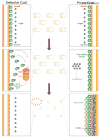Cell Death Pathway That Monitors Spore Morphogenesis
- PMID: 28408070
- PMCID: PMC5522370
- DOI: 10.1016/j.tim.2017.03.005
Cell Death Pathway That Monitors Spore Morphogenesis
Abstract
The use of quality control mechanisms to stall developmental pathways or completely remove defective cells from a population is a widespread strategy to ensure the integrity of morphogenetic programs. Endospore formation (sporulation) is a well conserved microbial developmental strategy in the Firmicutes phylum wherein a progenitor cell that faces starvation differentiates to form a dormant spore. Despite the conservation of this strategy, it has been unclear what selective pressure maintains the fitness of this developmental program, composed of hundreds of unique genes, during multiple rounds of vegetative growth when sporulation is not required. Recently, a quality control pathway was discovered in Bacillus subtilis which monitors the assembly of the spore envelope and specifically eliminates, through cell lysis, sporulating cells that assemble the envelope incorrectly. Here, we review the use of checkpoints that govern the entry into sporulation in B. subtilis and discuss how the use of regulated cell death pathways during bacterial development may help maintain the fidelity of the sporulation program in the species.
Keywords: SpoIVA; SpoVM; apoptosis; gametogenesis; lamins; nuclear envelope; programmed cell death.
Published by Elsevier Ltd.
Figures



Similar articles
-
A Quality-Control Mechanism Removes Unfit Cells from a Population of Sporulating Bacteria.Dev Cell. 2015 Sep 28;34(6):682-93. doi: 10.1016/j.devcel.2015.08.009. Epub 2015 Sep 17. Dev Cell. 2015. PMID: 26387458 Free PMC article.
-
Characterization of a sporulation gene, spoIVA, involved in spore coat morphogenesis in Bacillus subtilis.J Bacteriol. 1992 Jan;174(2):586-94. doi: 10.1128/jb.174.2.586-594.1992. J Bacteriol. 1992. PMID: 1729247 Free PMC article.
-
Shaping an Endospore: Architectural Transformations During Bacillus subtilis Sporulation.Annu Rev Microbiol. 2020 Sep 8;74:361-386. doi: 10.1146/annurev-micro-022520-074650. Epub 2020 Jul 13. Annu Rev Microbiol. 2020. PMID: 32660383 Free PMC article. Review.
-
Phenotypic memory in Bacillus subtilis links dormancy entry and exit by a spore quantity-quality tradeoff.Nat Commun. 2018 Jan 4;9(1):69. doi: 10.1038/s41467-017-02477-1. Nat Commun. 2018. PMID: 29302032 Free PMC article.
-
Bacillus subtilis spore coat.Microbiol Mol Biol Rev. 1999 Mar;63(1):1-20. doi: 10.1128/MMBR.63.1.1-20.1999. Microbiol Mol Biol Rev. 1999. PMID: 10066829 Free PMC article. Review.
Cited by
-
The Conserved Spore Coat Protein SpoVM Is Largely Dispensable in Clostridium difficile Spore Formation.mSphere. 2017 Sep 20;2(5):e00315-17. doi: 10.1128/mSphere.00315-17. eCollection 2017 Sep-Oct. mSphere. 2017. PMID: 28959733 Free PMC article.
-
Sporulation in solventogenic and acetogenic clostridia.Appl Microbiol Biotechnol. 2021 May;105(9):3533-3557. doi: 10.1007/s00253-021-11289-9. Epub 2021 Apr 26. Appl Microbiol Biotechnol. 2021. PMID: 33900426 Free PMC article. Review.
-
In silico insight of cell-death-related proteins in photosynthetic cyanobacteria.Arch Microbiol. 2022 Jul 21;204(8):511. doi: 10.1007/s00203-022-03130-2. Arch Microbiol. 2022. PMID: 35864385 Review.
-
Role of SpoIVA ATPase Motifs during Clostridioides difficile Sporulation.J Bacteriol. 2020 Oct 8;202(21):e00387-20. doi: 10.1128/JB.00387-20. Print 2020 Oct 8. J Bacteriol. 2020. PMID: 32817091 Free PMC article.
-
Understanding the ontogeny and succession of Bacillus velezensis and B. subtilis subsp. subtilis by focusing on kimchi fermentation.Sci Rep. 2018 May 4;8(1):7045. doi: 10.1038/s41598-018-25514-5. Sci Rep. 2018. PMID: 29728638 Free PMC article.
References
Publication types
MeSH terms
Substances
Grants and funding
LinkOut - more resources
Full Text Sources
Other Literature Sources
Molecular Biology Databases

